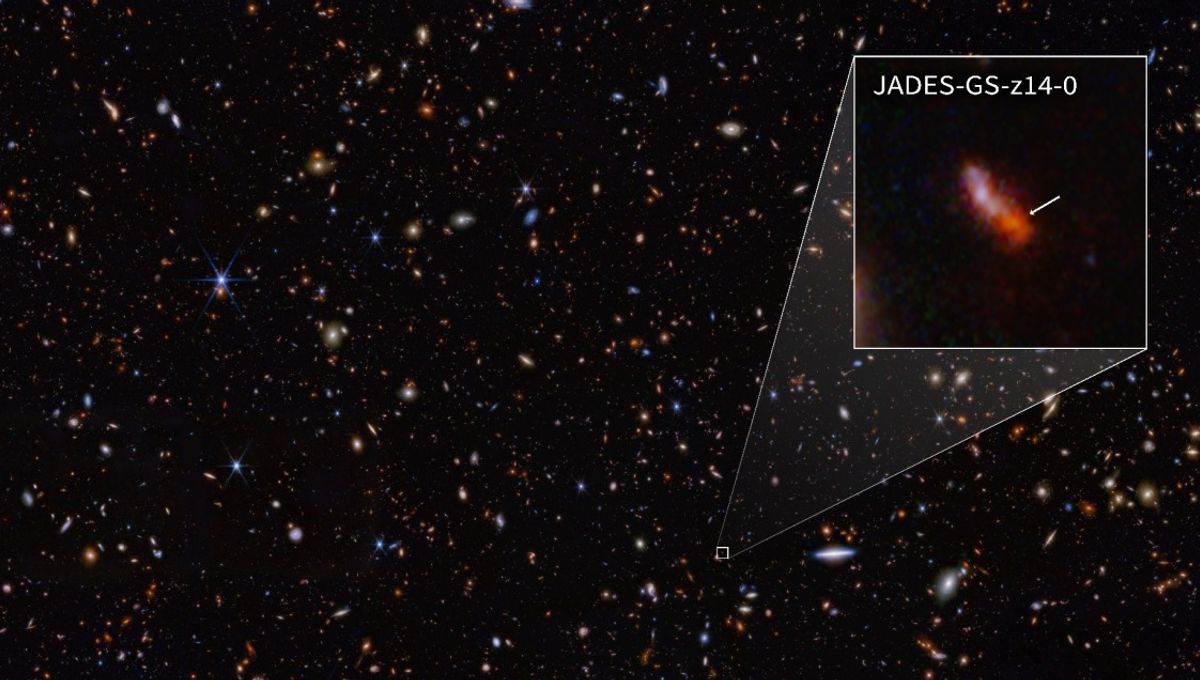
An international team of astronomers has announced the detection of two of the earliest and most distant galaxies known. The light of both of them comes from just 300 million years after the Big Bang and it was possible to observe them only thanks to the power of the James Webb Space Telescope (JWST).
The galaxies are located in a region near the Hubble Ultra Deep Field, the famous observations by the Hubble Space Telescope showing some of the most distant galaxies known at the time. JWST’s larger mirrors and infrared capabilities allowed astronomers to see even farther into the universe.
“These galaxies join a small but growing population of galaxies from the first half billion years of cosmic history where we can really probe the stellar populations and the distinctive patterns of chemical elements within them,” Dr Francesco D’Eugenio of the Kavli Institute for Cosmology at the University of Cambridge, one of the team behind the discovery, said in a statement.
The results are part of the JWST Advanced Deep Extragalactic Survey (JADES) and they are known as JADES-GS-z14-0 and JADES-GS-z14-1, with the former slightly more distant than the latter.
The team was able to conduct a spectroscopic survey of the galaxies, breaking their light into a rainbow. Using this rainbow, the researchers were able to work out how far away they are and what kind of chemical elements were present. This is possible because chemical elements interact with light at specific wavelengths.
And that is not all. Due to the expansion of the universe, light is redshifted. This is similar to the Doppler effect, which changes the pitch of an ambulance’s siren if the vehicle is approaching or receding. In the case of these galaxies, their light is stretched out to extreme wavelengths.
“We are seeing extra emission from hydrogen and possibly even oxygen atoms, as is common in star-forming galaxies, but here shifted out to an unprecedented wavelength,” said Jakob Helton, a graduate student at the University of Arizona and lead author of one of the papers detailing the discovery.
JADES-GS-z14-0 is small compared to the Milky Way, but mighty. It is 1,600 light-years across and is forming stars at a rate 20 times faster than our own quiet galaxy. Before JWST, astronomers didn’t expect galaxies to become big, bright, and massive very quickly, but galaxies like this suggest that this is definitely a way that they can grow.
“JADES-GS-z14-0 now becomes the archetype of this phenomenon,” said Dr Stefano Carniani of the Scuola Normale Superiore in Pisa, lead author on the discovery paper. “It is stunning that the Universe can make such a galaxy in only 300 million years.”
JWST is designed to look for the most distant galaxies yet discovered, so expect this current record holder to be replaced relatively soon. These observations suggest that objects significantly closer to the Big Bang might soon be found.
“We could have detected this galaxy even if it were 10 times fainter, which means that we could see other examples yet earlier in the Universe—probably into the first 200 million years,” said Brant Robertson, professor of astronomy and astrophysics at the University of California-Santa Cruz, and lead author of a third paper on the team’s study of the evolution of these galaxies. “The early Universe has so much more to offer.”
The papers related to the discovery are waiting for peer review, but have been posted to arXiv. The Carniani paper confirmed the distance, the Helton paper is all about the galactic properties, and the Robertson paper provides insights into how such a galaxy managed to grow so big in such a short time.
Source Link: New Record-Breaker: Earliest And Most Distant Galaxies Ever Found Spotted By JWST